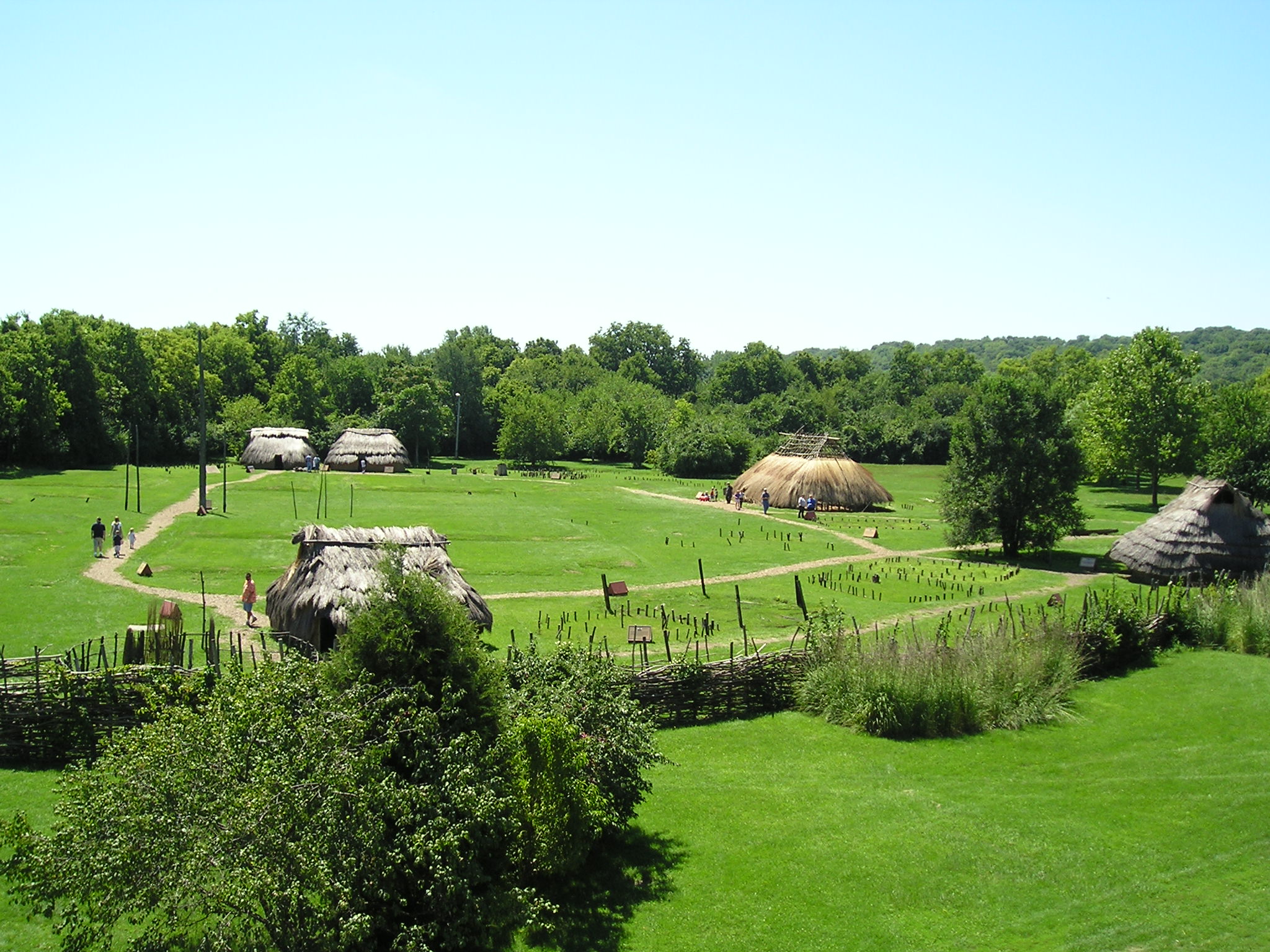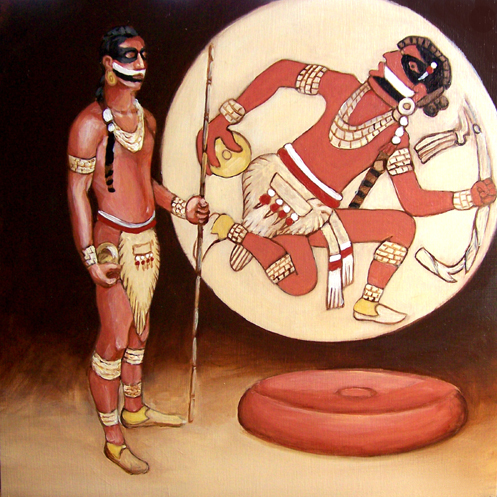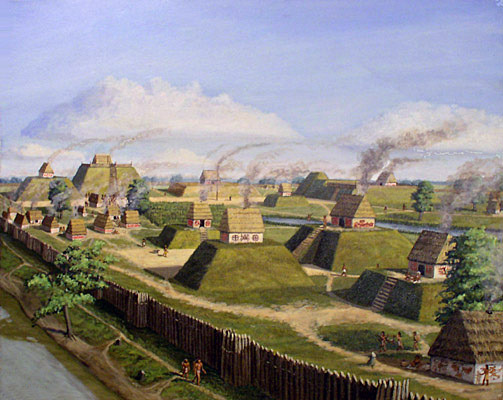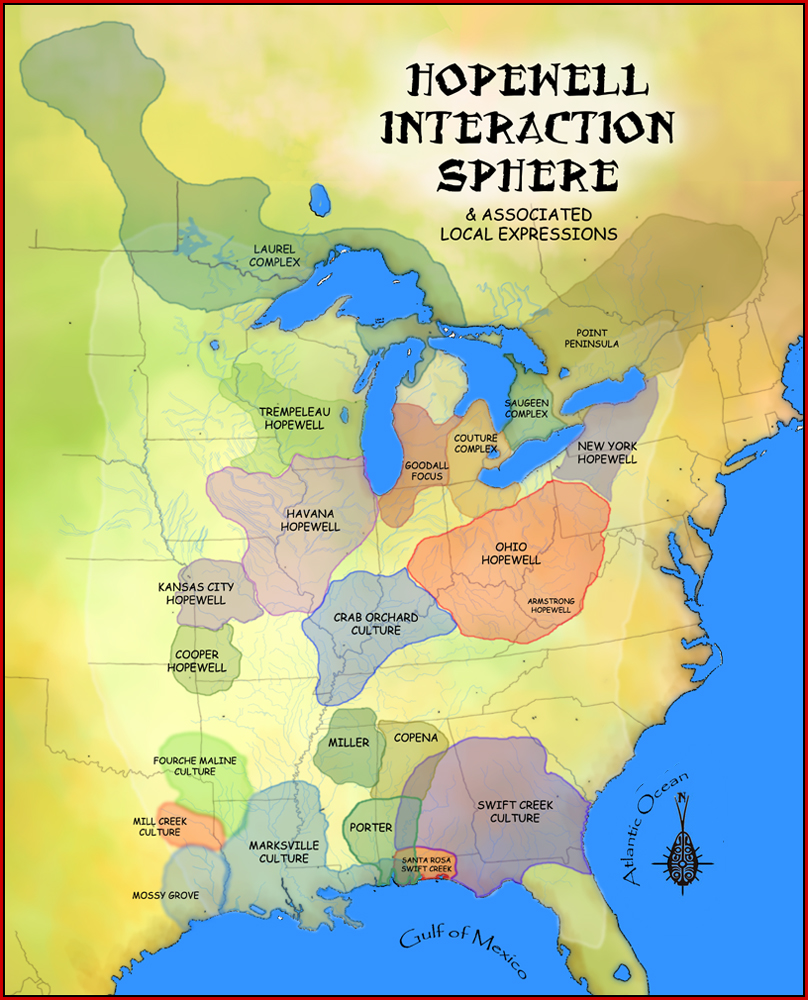|
Fort Ancient Culture
The Fort Ancient culture is a Native American archaeological culture that dates back to . Members of the culture lived along the Ohio River valley, in an area running from modern-day Ohio and western West Virginia through to northern Kentucky and parts of southeastern Indiana. A contemporary of the neighboring Mississippian culture, Fort Ancient is considered to be a separate "sister culture". Mitochondrial DNA evidence collected from the area suggests that the Fort Ancient culture did not directly descend from the older Hopewell Culture. Material evidence also suggests that the Fort Ancient peoples introduced maize agriculture to Ohio, and other evidence connects this culture to the Great Serpent Mound. In 1999, an archaeological study by Brad Lepper and Tod A. Frolking used radiocarbon testing to show that the Alligator Effigy Mound in Granville also dates to the Fort Ancient era, rather than the assumed Hopewell era. Both the Serpent and Alligator Mounds, first unders ... [...More Info...] [...Related Items...] OR: [Wikipedia] [Google] [Baidu] |
Fort Ancient, Ohio
Fort Ancient ( 33 WA 2) is a Native American earthworks complex located in Washington Township, Warren County, Ohio, along the eastern shore of the Little Miami River about southeast of Lebanon on State Route 350. The site is the largest prehistoric hilltop enclosure in the United States with three and one-half miles (18,000 ft) of walls in a complex. Built by the Hopewell culture, who lived in the area from the 200 BC to AD 400, the site is situated on a wooded bluff above the Little Miami. It is the namesake of a culture known as Fort Ancient who lived near the complex long after it was constructed. Maintained as a state historical park, the site was designated a National Historic Landmark for its significance. The State of Ohio purchased the land and made it Ohio's first state park in 1891. In addition, this is part of the Hopewell Ceremonial Earthworks, one of 14 sites nominated in January 2008 by the U.S. Department of the Interior for potential submission by the ... [...More Info...] [...Related Items...] OR: [Wikipedia] [Google] [Baidu] |
Chunkey
Chunkey (also known as chunky, chenco, tchung-kee or the hoop and stick game) is a game of Native Americans in the United States, Native American origin. It was played by rolling disc-shaped stones across the ground and throwing spears at them in an attempt to land the spear as close to the stopped stone as possible. It originated around 600 CE in the Cahokia region of what is now the United States (near modern St. Louis, Missouri, St. Louis, Missouri). Chunkey was played in huge arenas as large as 47 acres (19 ha) that housed great audiences designed to bring people of the region together (i.e. Cahokians, farmers, immigrants, and even visitors). Cahokians spread chunkey and other aspects of their culture into the South and Great Plains. They likely used this sport and the threat of force to enforce a region-wide peace, termed the "Pax Cahokiana". It continued to be played after the fall of the Mississippian culture around 1500 CE. Variations were played throughout North America. ... [...More Info...] [...Related Items...] OR: [Wikipedia] [Google] [Baidu] |
Palisade
A palisade, sometimes called a stakewall or a paling, is typically a row of closely placed, high vertical standing tree trunks or wooden or iron stakes used as a fence for enclosure or as a defensive wall. Palisades can form a stockade. Etymology ''Palisade'' derives from ''pale'', from the Latin word ', meaning stake, specifically when used side by side to create a wood defensive wall. In turn, ''pālus'' derives from the Old Italic word ''palūts'', which may possibly derive from the Proto-Indo-European word ''pelh'', meaning pale or gray. It may be related to the Proto-Uralic word ''pil'me'' (uncertain meaning) or the word ''pilwe'', meaning cloud. (see wikt:pale#Etymology_2, 'pale', English: Etymology 2 on Wiktionary). Typical construction Typical construction consisted of small or mid-sized tree trunks aligned vertically, with as little free space in between as possible. The trunks were sharpened or pointed at the top, and were driven into the ground and sometimes rein ... [...More Info...] [...Related Items...] OR: [Wikipedia] [Google] [Baidu] |
Platform Mound
A platform mound is any earthwork or mound intended to support a structure or activity. It typically refers to a flat-topped mound, whose sides may be pyramidal. In Eastern North America The indigenous peoples of North America built substructure mounds for well over a thousand years, starting in the Archaic period and continuing through the Woodland period. Many different archaeological cultures ( Poverty Point culture, Troyville culture, Coles Creek culture, Plaquemine culture and Mississippian culture) of North Americas Eastern Woodlands are specifically well known for using platform mounds as a central aspect of their overarching religious practices and beliefs. These platform mounds are usually four-sided truncated pyramids, steeply sided, with steps built of wooden logs ascending one side of the earthworks. When Europeans first arrived in North America, the peoples of the Mississippian culture were still using and building platform mounds. Documented uses for Mi ... [...More Info...] [...Related Items...] OR: [Wikipedia] [Google] [Baidu] |
Solstice
A solstice is the time when the Sun reaches its most northerly or southerly sun path, excursion relative to the celestial equator on the celestial sphere. Two solstices occur annually, around 20–22 June and 20–22 December. In many countries, the seasons of the year are defined by reference to the solstices and the equinoxes. The term ''solstice'' can also be used in a broader sense, as the day when this occurs. For locations not too close to the equator or the poles, the dates with the longest and shortest periods of daylight are the summer and winter solstices, respectively. Terms with no ambiguity as to which hemisphere is the context are "June solstice" and "December solstice", referring to the months in which they take place every year. Etymology The word ''solstice'' is derived from the Latin () and (), because at the solstices, the Sun's declination appears to "stand still"; that is, the seasonal movement of the Sun's sun path, daily path (as seen from Earth) paus ... [...More Info...] [...Related Items...] OR: [Wikipedia] [Google] [Baidu] |
Nuclear Family
A nuclear family (also known as an elementary family, atomic family, or conjugal family) is a term for a family group consisting of parents and their children (one or more), typically living in one home residence. It is in contrast to a single-parent family, a larger extended family, or a family with more than two parents. Nuclear families typically center on a Marriage, married couple that may have any number of children. There are differences in definition among observers. Some definitions allow only biological children who are full-blood siblings, some consider adopted or half- and step-siblings a part of the immediate family, but others allow for a step-parent and any mix of dependent children, including stepchildren and adopted children. Some sociologists and anthropologists consider the extended family structure to be the most common family structure in most cultures and at most times for humans, rather than the nuclear family. The term ''nuclear family'' was popularize ... [...More Info...] [...Related Items...] OR: [Wikipedia] [Google] [Baidu] |
Maize
Maize (; ''Zea mays''), also known as corn in North American English, is a tall stout grass that produces cereal grain. It was domesticated by indigenous peoples in southern Mexico about 9,000 years ago from wild teosinte. Native Americans planted it alongside beans and squashes in the Three Sisters polyculture. The leafy stalk of the plant gives rise to male inflorescences or tassels which produce pollen, and female inflorescences called ears. The ears yield grain, known as kernels or seeds. In modern commercial varieties, these are usually yellow or white; other varieties can be of many colors. Maize relies on humans for its propagation. Since the Columbian exchange, it has become a staple food in many parts of the world, with the total production of maize surpassing that of wheat and rice. Much maize is used for animal feed, whether as grain or as the whole plant, which can either be baled or made into the more palatable silage. Sugar-rich varieties called sw ... [...More Info...] [...Related Items...] OR: [Wikipedia] [Google] [Baidu] |
Woodland Period
In the classification of :category:Archaeological cultures of North America, archaeological cultures of North America, the Woodland period of North American pre-Columbian cultures spanned a period from roughly 1000 BC to European contact in the eastern part of North America, with some archaeologists distinguishing the Mississippian period, from 1000 AD to European contact as a separate period. The term "Woodland Period" was introduced in the 1930s as a generic term for prehistoric, prehistoric sites falling between the Archaic period in the Americas, Archaic hunter-gatherers and the agriculturalist Mississippian cultures. The Eastern Woodlands cultural region covers what is now eastern Canada south of the Subarctic region, the Eastern United States, along to the Gulf of Mexico. This period is variously considered a developmental stage, a time period, a suite of technological adaptations or "traits", and a "family tree" of cultures related to earlier Archaic cultures. ... [...More Info...] [...Related Items...] OR: [Wikipedia] [Google] [Baidu] |
Fort Ancient Monongahela Cultures HRoe 2010
A fortification (also called a fort, fortress, fastness, or stronghold) is a military construction designed for the defense of territories in warfare, and is used to establish rule in a region during peacetime. The term is derived from Latin ("strong") and ("to make"). From very early history to modern times, defensive walls have often been necessary for cities to survive in an ever-changing world of invasion and conquest. Some settlements in the Indus Valley Civilization were the first small cities to be fortified. In ancient Greece, large cyclopean stone walls fitted without mortar had been built in Mycenaean Greece, such as the ancient site of Mycenae. A Greek '' phrourion'' was a fortified collection of buildings used as a military garrison, and is the equivalent of the Roman castellum or fortress. These constructions mainly served the purpose of a watch tower, to guard certain roads, passes, and borders. Though smaller than a real fortress, they acted as a border gu ... [...More Info...] [...Related Items...] OR: [Wikipedia] [Google] [Baidu] |
Archaeologist
Archaeology or archeology is the study of human activity through the recovery and analysis of material culture. The archaeological record consists of Artifact (archaeology), artifacts, architecture, biofact (archaeology), biofacts or ecofacts, archaeological site, sites, and cultural landscapes. Archaeology can be considered both a social science and a branch of the humanities. It is usually considered an independent academic discipline, but may also be classified as part of anthropology (in North America – the four-field approach), history or geography. The discipline involves Survey (archaeology), surveying, Archaeological excavation, excavation, and eventually Post excavation, analysis of data collected, to learn more about the past. In broad scope, archaeology relies on cross-disciplinary research. Archaeologists study human prehistory and history, from the development of the first stone tools at Lomekwi in East Africa 3.3 million years ago up until recent decades. A ... [...More Info...] [...Related Items...] OR: [Wikipedia] [Google] [Baidu] |








